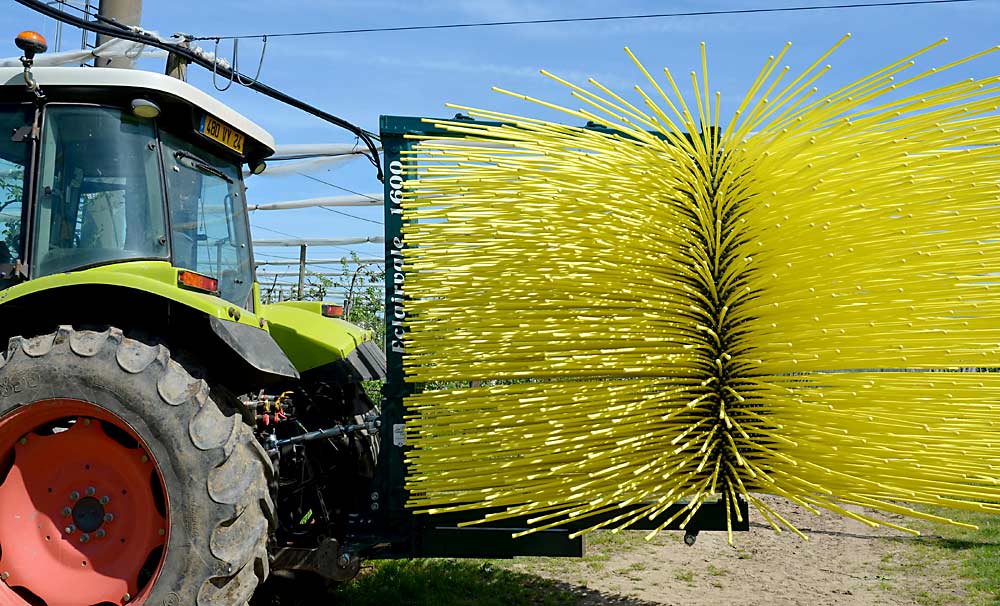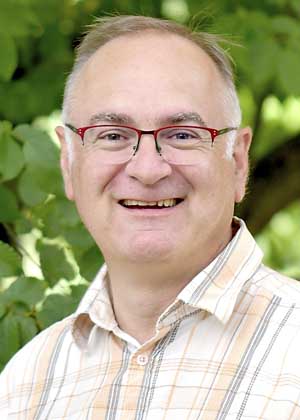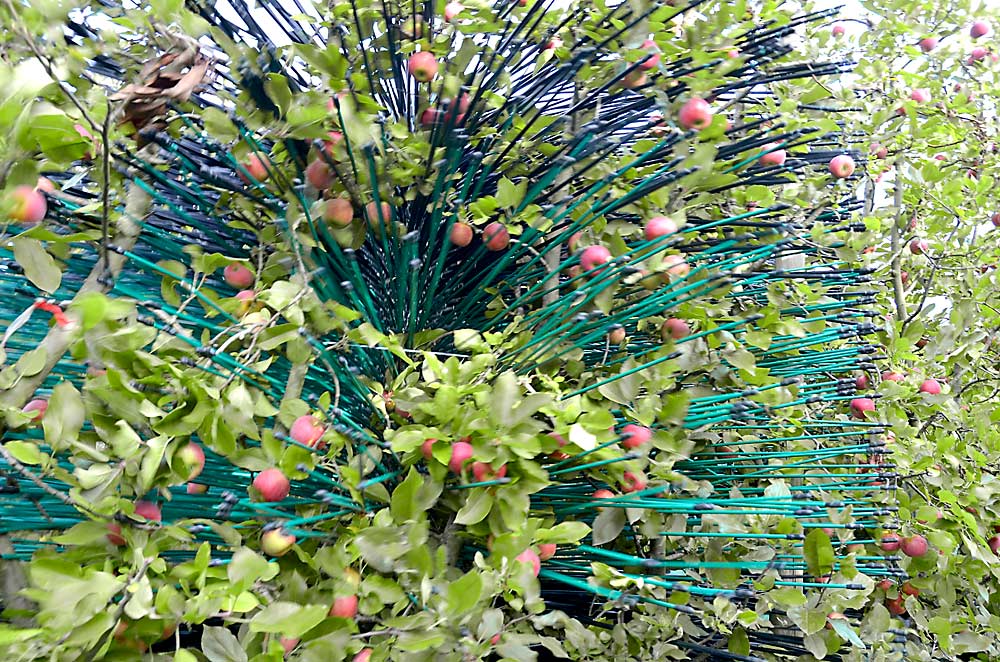

Eclairvale is a new fruit thinning tool developed and trademarked by the French company La Canne Vale. The CTIFL (French center for research on fruit and vegetables) has been testing the device since 2015. With semirigid rods designed to remove fruit from narrow fruit tree hedges, the tool allows for optimal fruit load management by quickly and mechanically removing the fruitlets from an apple tree. This summary of results will demonstrate the effectiveness of the Eclairvale tool, as well as its outstanding performance when paired with another mechanical tool, the Darwin string thinner from German manufacturer Fruit-Tec.. When harvested, the fruits of trees thinned by the Eclairvale have displayed only minor superficial bruises, and ongoing improvements to the tool will reduce such imperfections even more.
Mechanical thinning
For many varieties of fruit trees, the annual thinning of flowers and fruitlets is a crucial step in regulating the number of fruits per tree, improving the quality of the fruits and avoiding the phenomenon of biennial bearing.
In light of society’s increasing aversion to pesticides and growing demand for organic products, it has become necessary to develop new tools that allow for more environmentally friendly farming. As a result, work on mechanical apple tree thinning devices got underway in the 2000s at the CTIFL center in Lanxade. Several years ago, after various experiments with prebloom mechanical thinning, the center began to test a new device called Eclairvale, which is capable of thinning fruitlets.
Prebloom mechanical thinning is done with flexible wires that are set into motion by a mechanical device. This practice allows for an apple tree’s blossoms to be reduced by 30 to 50 percent. However, if used alone, this technique does not provide for the sufficient thinning of all varieties of apple trees.
The Eclairvale tool
The device, initially designed by French company La Canne Vale and its founder, Mr. Villanou, for the mechanical thinning of stone fruit, appears to also be suitable for the mechanical thinning of other types of fruit trees, including the apple tree.
Eclairvale is a truly innovative arboricultural tool. It is the first postbloom mechanical tool that can regulate the fruit load of several types of fruit trees and varieties in a uniform manner. The intentionally simple design ensures that it remains reliable, sturdy and easy to maintain cost-effectively.
The 2,800 semirigid rods are at the heart of the tool’s innovation, for they penetrate the foliage of the trees, brushing against the fruit sideways to allow it to fall to the ground. The rods’ design has been optimized for efficient thinning, rigid enough to remove fruit but not enough to snap branches or spurs, along with a protective coating that prevents fruit bruising. The rods can be adjusted for each specific tree type and usage (peach, plum, almond, etc.).
Thinning apple trees
When it comes to apple trees, Eclairvale initially hopes to meet the thinning needs of the apple industry with regard to juice and the organic production of various apple varieties.
Considering the design of the device and, in particular, the length of its rods, Eclairvale is best suited for narrow fruit tree hedges such as Aximum and fruit wall training systems, or systems built with rigid fruit branches. Eclairvale can also be used on wider hedges but tends to be less effective at thinning the interior of the canopy and the small dangling branches that bear fruit. The closer the rotor (axle holding the rods) is to the hedge, the deeper the rods will penetrate into the foliage and the more effective the Eclairvale thinning will be.
Varieties with short stems are more likely to be removed by Eclairvale than varieties with long stems. As the specifications for each variety vary, the best time to use Eclairvale and ensure enough fruit is removed depends on the individual cultivar. For the Ariane variety, Eclairvale produced excellent thinning results once the apples had reached a diameter of 35 mm. For Gala, the 44 mm stage seems best.
The tool’s work speed also has an impact on the effectiveness of the thinning. An increase in the speed at which Eclairvale advances will result in more fruit being thinned from the tree. There is also, however, a positive correlation between speed and bruising. Tests performed in 2017 on the Ariane variety showed how traveling at slow speeds (less than or equal to a maximum of 3 kilometers per hour, km/h) can optimize the fruit load and minimize waste.

The main constraints of Eclairvale
Once a tree has blossomed and its ovules are pollinated, fruitlets begin to develop very quickly. At this stage, fruitlets are extremely delicate and fragile. Eclairvale must thin these fruitlets at an early stage without bruising the remaining fruits and making them unfit for sale. The device must also be careful not to remove too many leaves and spurs.
Finally, as most apple orchards are grown with M9-style rootstocks (minimal rooting), Eclairvale must be used with strong and sturdy training structures whose trees are firmly attached to the top wire.
Results on Buckeye Gala
Effectiveness tests were performed on two blocks of Buckeye Gala trees that were either Aximum or fruit wall trained and in their sixth year of production. The Aximum system, trademarked by CTIFL, is a narrow fruit tree training system that grows without mechanical pruning, while the fruit wall is a narrow system which is mainly pruned by mechanical means.
The 2017 trial included nine treatments across the two systems to see how the Eclairvale compared to standard thinning practices. Treatments compared different combinations of chemical thinning with NAA and BA, hand thinning, Darwin blossom thinning, and the Eclairvale running at different stages of fruitlet growth, different ground speed, and with two different rods of varying rigidity. (Click here for an addendum with full methods and results.)
The average number of fruits per tree varied greatly for each method. The chemical thinning without manual thinning resulted in the largest number of fruits per tree (233), and the treatment that combined blossom thinning and chemical thinning and hand thinning resulted in the fewest number of fruits per tree (111 and 92) for both training systems.
One single thinning with Eclairvale proved insufficient for properly adjusting the crop loads. On the other hand, the entirely mechanical methods (prebloom Darwin and postbloom Eclairvale with no additional thinning) worked extremely well for both the Aximum and fruit wall systems, comparable to the chemical thinning followed by hand thinning.
In the fruit wall training system, the combination of Darwin, chemical thinning, and Eclaivale, without hand thinning, also produced very good results. Eclairvale does not completely eliminate the need for manual thinning but considerably increases the fruit size despite its late application (the 44 mm stage on Buckeye Gala). At earlier stages, Eclairvale thinning is insufficient for this variety.
For each method, 200 of the fruits were checked for bruises. Overall, the tests on the Buckeye Gala trees resulted in little to no bruises less than 1 cm² (0 to 1.5 percent) and little to somewhat more bruises larger than 1 cm² (2 to 8 percent). Larger bruises were seen in the treatments where Eclairvale was run too fast (5 or 6 km/h), but bruising in the Darwin and Eclairvale combo when it ran at 2 km/h showed comparable bruising as seen in the Darwin, chemical and hand thinning treatment from other sources.
Conclusion
Eclairvale is an innovative new device for thinning fruitlets that differs from existing tools such as vibrators and shakers. The use and speed can be customized to ensure a fruit tree is properly thinned, without causing significant damage which might be harmful to the tree’s development. Eclairvale is simple, efficient, sturdy and energy-efficient. It can quickly increase the competitiveness of companies and contribute to the development of more environmentally friendly farming.
After three years of tests, Eclairvale has become perfectly suitable for the postbloom thinning of several varieties of apple trees used by industrial orchards to make products such as juice, syrup and compote, as well as various types of organic apples, provided such orchards are willing to accept that a small percentage of the fruits will be bruised (with the current version of the tool).
Nonetheless, the quality of the mechanical thinning will depend on a variety of different factors, including the quality of the rods, the choice of tree variety, the positioning of Eclairvale in the hedge, the training of the orchard and the speed at which the device advances.
As is the case for most thinning techniques, Eclairvale should be used in combination with other techniques to optimize agronomic performance (fruit size and crop load management). In this study on apple trees, we have demonstrated the effectiveness of Eclairvale when used with the Darwin tool and thus presented an entirely mechanical solution that involves neither chemical nor manual thinning.
The knowledge acquired from this study (and future studies) will allow for improvements to be made to Eclairvale, in particular to the tool’s rods, which will be designed without the rigid end pieces that are responsible for the majority of the bruises. Additional work will seek to optimize orchards (hedge thickness, training quality) and determine which varieties are best suited for this technique. •
—by Laurent Roche
Laurent Roche is an engineer specializing in apple tree management at CTIFL, the French center for research on fruit and vegetables. In the 1990s, he and Alain Masseron pioneered the fruiting wall concept.






Leave A Comment